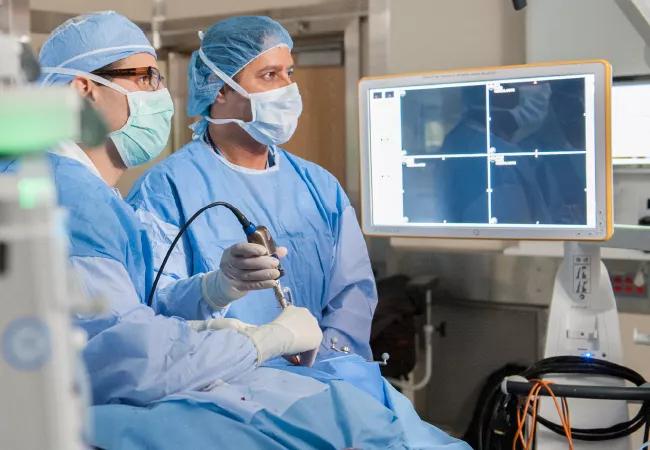Head & neck surgeon and neurosurgeon perform complex endonasal procedure

Endoscopic sinus and skull base surgeon Raj Sindwani, MD, and neurosurgeon Pablo Recinos, MD, partner on complex endoscopic skull base surgeries that rely on a “two surgeons, four hands” simultaneous approach rather than the tag-team approach of traditional endonasal pituitary surgery.
Advertisement
Cleveland Clinic is a non-profit academic medical center. Advertising on our site helps support our mission. We do not endorse non-Cleveland Clinic products or services. Policy
These procedures have proliferated greatly since 2014 with the launch of Cleveland Clinic’s Minimally Invasive Cranial Base and Pituitary Surgery Program, a multidisciplinary collaboration between Cleveland Clinic’s Head & Neck Institute and the Neurological Institute’s Rose Ella Burkhardt Brain Tumor and Neuro-Oncology Center.
Given the success of the two-surgeon approach, the team now routinely employs its expertise for the management of other complex pathologies located in hard to reach areas of the head. Dr. Sindwani and Dr. Recinos recently used an endoscopic, endonasal approach for resection of an intraorbital/orbital apex l hemangioma for a patient who was having severe progressive vision loss due to the mass. This was a challenging procedure due to the deep location of the tumor within the intraconal space of the eye, and because of its close proximity to the optic nerve. They selected the safest endoscopic corridor to approach the tumor (between the inferior and medial rectus muscles) and removed the mass without any cuts or bruises. The patient’s vision was restored to normal.
See how the tumor was removed and learn more about the patient’s amazing outcome in this video showing step by step how the procedure was done.
Advertisement
Advertisement

Large NIH-funded investigation is exploring this understudied phenomenon

Advances in genomics, spinal fluid analysis, wearable-based patient monitoring and more

Case study of radial-to-axillary nerve transfer for tumor-related deltoid nerve injury

An update on the technology from the busiest Gamma Knife center in the Americas

Real-time adjustments may help reduce bothersome dyskinesias

Anatomical modeling can identify optimal surgical candidates, study suggests

Add AI to the list of tools expected to advance care for pain patients

New guidelines from Brain Trauma Foundation urge early and aggressive treatment